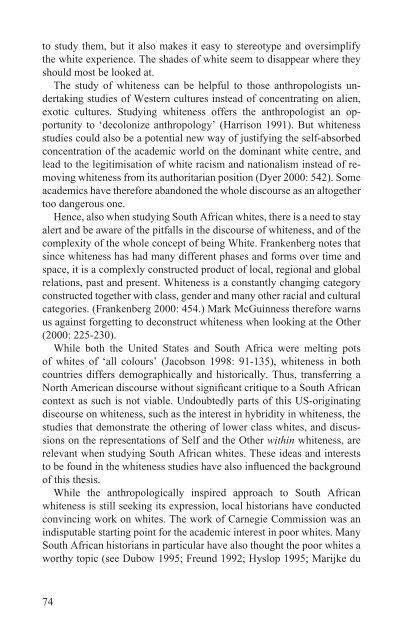The Making of a Good White - E-thesis - Helsinki.fi
The Making of a Good White - E-thesis - Helsinki.fi
The Making of a Good White - E-thesis - Helsinki.fi
Create successful ePaper yourself
Turn your PDF publications into a flip-book with our unique Google optimized e-Paper software.
to study them, but it also makes it easy to stereotype and oversimplify<br />
the white experience. <strong>The</strong> shades <strong>of</strong> white seem to disappear where they<br />
should most be looked at.<br />
<strong>The</strong> study <strong>of</strong> whiteness can be helpful to those anthropologists undertaking<br />
studies <strong>of</strong> Western cultures instead <strong>of</strong> concentrating on alien,<br />
exotic cultures. Studying whiteness <strong>of</strong>fers the anthropologist an opportunity<br />
to ‘decolonize anthropology’ (Harrison 1991). But whiteness<br />
studies could also be a potential new way <strong>of</strong> justifying the self-absorbed<br />
concentration <strong>of</strong> the academic world on the dominant white centre, and<br />
lead to the legitimisation <strong>of</strong> white racism and nationalism instead <strong>of</strong> removing<br />
whiteness from its authoritarian position (Dyer 2000: 542). Some<br />
academics have therefore abandoned the whole discourse as an altogether<br />
too dangerous one.<br />
Hence, also when studying South African whites, there is a need to stay<br />
alert and be aware <strong>of</strong> the pitfalls in the discourse <strong>of</strong> whiteness, and <strong>of</strong> the<br />
complexity <strong>of</strong> the whole concept <strong>of</strong> being <strong>White</strong>. Frankenberg notes that<br />
since whiteness has had many different phases and forms over time and<br />
space, it is a complexly constructed product <strong>of</strong> local, regional and global<br />
relations, past and present. <strong>White</strong>ness is a constantly changing category<br />
constructed together with class, gender and many other racial and cultural<br />
categories. (Frankenberg 2000: 454.) Mark McGuinness therefore warns<br />
us against forgetting to deconstruct whiteness when looking at the Other<br />
(2000: 225-230).<br />
While both the United States and South Africa were melting pots<br />
<strong>of</strong> whites <strong>of</strong> ‘all colours’ (Jacobson 1998: 91-135), whiteness in both<br />
countries differs demographically and historically. Thus, transferring a<br />
North American discourse without signi<strong>fi</strong>cant critique to a South African<br />
context as such is not viable. Undoubtedly parts <strong>of</strong> this US-originating<br />
discourse on whiteness, such as the interest in hybridity in whiteness, the<br />
studies that demonstrate the othering <strong>of</strong> lower class whites, and discussions<br />
on the representations <strong>of</strong> Self and the Other within whiteness, are<br />
relevant when studying South African whites. <strong>The</strong>se ideas and interests<br />
to be found in the whiteness studies have also influenced the background<br />
<strong>of</strong> this <strong>thesis</strong>.<br />
While the anthropologically inspired approach to South African<br />
whiteness is still seeking its expression, local historians have conducted<br />
convincing work on whites. <strong>The</strong> work <strong>of</strong> Carnegie Commission was an<br />
indisputable starting point for the academic interest in poor whites. Many<br />
South African historians in particular have also thought the poor whites a<br />
worthy topic (see Dubow 1995; Freund 1992; Hyslop 1995; Marijke du<br />
74
















